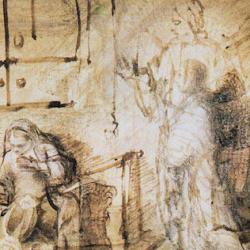Brief reflections on a sermon on Genesis 3 given by Eric Venable at Trinity Presbyterian Church (TPC). The sermon will be available on TPC’s web site in a week or two.
1) Eric emphasized the competing voices of the narrative. God speaks the world into being, and gives commandments, positive (“be fruitful, multiply, subdue, rule”) and negative (“thou shalt not eat”). Adam speaks to Eve. Genesis 3 introduces a new character, the serpent, who also has a speaking part. After the fall, Adam and Eve hear the qol, the voice, of Yahweh in the spirit of the day, and the Lord rebukes Adam for listening to the voice of his wife.
2) The voices come from outside. God speaks to Adam, Adam to Eve, the serpent to Eve. Outside voices get into our heads and take on a life of their own, but they begin on the outside. We are guided, all of us, by authoritative words. Genesis 1-3 presents a radically anti-autonomous understanding of human existence. The issue isn’t, voice or no voice. It’s always, whose voice? To whom do we open our ears?
3) God speaks imperatives, the serpent in skeptical interrogatives. “Has God said?” Eric pointed out that after the fall, Yahweh also comes with questions: “Where are you? Who told you? Have you eaten?” He doesn’t start with condemnation and curses. The Lord’s response is chiastically arranged:
a. To man: vv. 9-12
b. To woman: v. 13
c. Curse of serpent, vv. 14-15
b’. Curse of woman, v. 16
a’. Curse of man, vv. 17-19
4) Yahweh’s voice comes first as a summons, calling Adam from his shameful hiding. Then He calls Adam to confession. This is a judicial interrogation, but it’s designed to bring Adam to self-knowledge and to elicit acknowledgement of guilt. Yahweh does curse, but He first interrogates, and the interrogation is a gracious call to Adam to come clean in Yahweh’s presence.
5) There’s a liturgical structure of sorts in the passage: Yahweh arrives in the Spirit of the day; He calls Adam to appear; He summons Adam and Eve to confession and repentance; the chapter climaxes with a sacrifice and covering (atonement), and then a dismissal from the garden.












